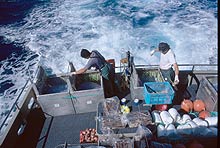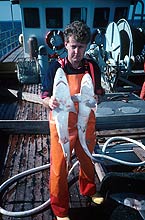|
Shark fishing in Australia
Fishing for sharks has a long history in Australia. Reports of the activities of the first white settlers, who arrived in Australia in 1788, show they supplemented their food resources by fishing. Sharks were caught and eaten, oil extracted from livers for uses such as lighting.
Southern shark fisheries
In 1927 a school shark fishery began in southern Australia. This has grown into Australia’s major shark fishery—the Southern Shark Fishery. In 1972 the discovery of high levels of mercury (a poisonous metal) in sharks led to a ban on the sale of large school sharks in Victoria. Over the years 1970–2000, school and gummy shark provided nearly all the catch from the Southern Shark Fishery. The rest was sawshark, elephant fish and other species. The total catch was highest in 1987 at 4228 tonnes.
Since then it has been decreasing with 2333 tonnes in 2001. School shark has been assessed as overfished for a number of years and management of the fishery has focused on reducing their catch. The main sharks targeted in other southern shark fisheries are whiskery shark, dusky shark and gummy shark. Dusky and whiskery sharks are assessed as overfished. Other species caught in these fisheries are sandbar sharks, hammerhead sharks, wobbegongs and school sharks. Managers of these fisheries have also introduced restrictions to reduce catches of overfished species.
Northern shark fisheries
Sharks were fished commercially off northern Australia between 1974 and 1986 by vessels from Taiwan, their highest catch being about 10 000 tonnes in 1977. Australians began fishing commercially for shark in northern Australia in about 1980. The principal fishing method in the Northern Shark Fishery is gillnetting, with the most activity in waters off the Northern Territory. The main sharks taken are two species of black-tip shark. The total shark catch in the Northern Territory in 2002 was 656 tonnes.
The level of fishing by Australian fishers for the two black-tip shark species is thought to be sustainable. However, high catches by Indonesian fishers are putting these and other sharks at risk. |

Longline vessel fishing out of Mooloolooba
setting the gear (© Peter Ward)

School shark and gummy shark
aboard vessel in Bass Strait
(© Russell Reichelt)
|
Other fisheries
Sharks are often a bycatch of many other fisheries. Some is retained for sale, but much of it is thrown away. Trawl fisheries such as the South East Trawl Fishery have a high level of shark bycatch. Recording of shark catch has been poor in these fisheries, but changes to fishery logbooks and the improvement of bycatch action plans are improving the recording effort. Dogfish, angel sharks, gummy sharks and school sharks are the main sharks caught in the South East Trawl Fishery.
Tuna longline fisheries catch large amounts of shark. The major tuna fisheries in Australia only allow 20 sharks to be landed by the boat per trip. Sharks usually caught by tuna longlines include blue sharks, bronze whaler sharks, porbeagles, makos, threshers and hammerhead sharks.
Alex Gaut ( MESA) adapted this information sheet (which is suitable for primary school students) from the information sheet compiled for the general public by © Kevin McLoughlin (kevin.mcloughlin@brs.gov.au) .
This information sheet may be copied for educational purposes. For any other purpose please contact your State MESA representative: http://www.mesa.edu.au/council/contacts.asp
|
